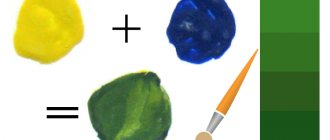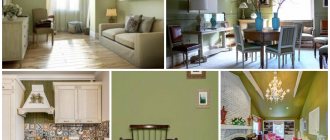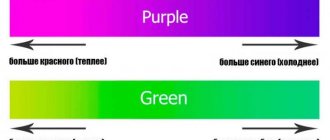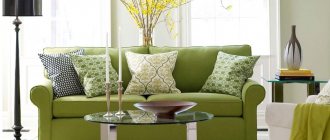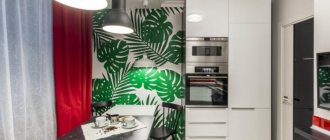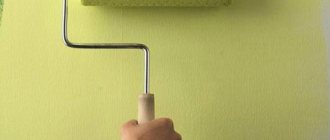Color Basics
The science called coloristics studies colors, their features and combinations. Any artist, even a beginner, has an idea of how to get a particular shade by mixing paints, and, naturally, knows how to get green.
You may not believe it, but all the objects around you are painted in only 3 colors. They are called basic. These are red, yellow and blue. By mixing these colors and using black and white, thousands of shades can be created: brown, purple, pink, orange and many more. By learning these basics, future artists will also learn how to produce the color green.
The color ring is used to visually study color. It is convenient to use it to determine which color needs to be mixed with which in order to obtain more complex shades. Moreover, changing the proportions of the initial colors also changes the final one. Paints from different companies may differ slightly in color - this also needs to be taken into account when mixing.
Brown
Depending on what base color you need, combine:
- Green with red pigment;
- The same bright red shade with yellow and blue;
- Yellow paint with white, black and red;
- Mix orange with blue or gray.
Variations of brown are created as follows:
Mustard
A yellow paint pigment combined with red, green and a small amount of black;
Medium brown
Add red and blue to yellow paint, lighten with white, and darken with black;
Beige tone
It works if you gradually add white to brown, and then create brightness using yellow;
Yellow and orange
Summer landscapes cannot be imagined without these shades.
Eggshell color
It can be conveyed if you add yellow and a drop of brown to white paint;
Read also: This cannot be done in Thailand
A realistic skin color is achieved by a yellow-brown tint with the addition of a large amount of white.
Yellow-green color goes well with other colors
Yellow-green combines with other colors in ringing pairs, more often warm than cold. Warm tones enhance the warm nature of the tone, while cool tones make it cooler than we see it in the warm neighborhood.
Color combination: yellow-green and pink is a delicate combination of pastel colors, but even if the main tone is extremely bright (acidic), such a palette is pleasing to the eye. Choose a pair of shades such as pale pink, sakura, carnation, sunset, hot pink.
The combination of yellow-green and red is the utmost brightness and expressiveness. It contains echoes of an additional pair (red, green), and there is both contrast in lightness and warmth. Consider tandems with scarlet, Chinese red, red-orange, cardinal, Bismarck Furioso.
The combination of yellow-green and orange is no less bright than yellow-red, however, the similarity of tones plays a role in it, which affects the harmony as a whole. To create a pleasant color scheme, choose shades such as light peach, mango, orange-coral, tangerine, pumpkin.
A combination of yellow-green and yellow. If the described tone is considered as a shade of yellow, then it can be classified as a cold line in this range. Therefore, although this is a combination of related shades, the pair will have a warm-cold contrast. For a pair, choose the following colors: pale yellow, sunny yellow, straw, yellow gold, bright gold.
Yellow-green is combined with warm shades of green, a palette consisting of shades in the same range. The main shade becomes a bright reflection of the sun, darker greens deepen the magic of the tone, making it lively and fabulous. To create this look, combine it with pistachio, avocado, light green, olive, and swamp.
Yellow-green goes well with cool shades of green. This combination of cold and warm is deep, fresh, alive. Cold greenery acts as a shadow, and the main color acts as a highlight, as in the previous case. Consider pairs with green water tones, menthol, jade, emerald green, emerald.
Color combination: yellow-green and blue. Soft, watery shades, such as blue water tone, thrush egg color, dark turquoise, denim, Prussian blue have a refreshing effect on the described color. They remind you of relaxation and the sunny sea.
The combination of yellow-green and purple is a surprisingly harmonious, exotic combination that adds charm and piquancy to everything where it appears. For clarity, study the example with blue-violet, thistle, lavender, blackberry, purple.
The combination of yellow-green and brown is a natural combination of young greenery with woody tones - a warm, contrasting palette. To create it, you can choose tones such as camel, light brown, bronze, light chestnut, red chestnut.
A combination of yellow-green with white, gray, black. Bright shades of the main color can very advantageously emphasize neutral tones, such as cream, papyrus, beige, gray wood, graphite. They will muffle the obsessive shrillness and increase the presentability of the image.
Light green
So we know what colors to mix to make green. But how to clarify the result? Just add white. For classic light green, the proportions are 2:1:1. That is, there is 2 times more white. The resulting warm shade can be varied. More white – the paint becomes lighter. Less - it is juicier. This produces different shades, from soft pastel to cheerful bright green.
You can do it differently and replace blue with light blue. As a result, we have the same light green paint. In this case, you can change the brightness by varying the proportions of blue.
Creating color by combining paints
What colors should you mix to make green? To answer the question, you need to look at what the color wheel looks like. Green and its shades are located between yellow and blue, therefore, these tones will allow you to get the desired color scheme. Classic green can be made by combining equal proportions of the above colors. All shades of green are produced by changing the ratio or introducing new pigments.
lightauthorcommentarticlesitetablequantitygrayvisiblelinkssharebackyourhomecleanbasicmaterialsworkcolorsvkontaktefacebookclassmates
Variety of green
The original green is usually presented in all sets; if the required dye is not available, there are no problems obtaining it. Pairing yellow with blue gives the desired green background. But any direction of creativity, be it painting, interior design or another option for decorating objects, requires a wide palette of green. The basic principle of all experiments is to change the proportions of the base colors; white or black dye is used to lighten or darken the background.
Next we will talk about mixing options and the results of the experiment:
- The combination of blue and yellow with a small addition of brown represents khaki. Green with a small amount of yellow forms olive.
- Traditional light green is the result of mixing green and white.
Adding yellow or blue will help regulate warmth. ?Attention! The quality of the starting components affects the saturation of the green color. The more intense the base tones, the brighter the blending result will be. - A yellow-green effect can be achieved by combining yellow and blue in a 2:1 ratio. The inverse proportion will result in a blue-green tone.
- Dark green color is achieved by adding half the amount of black.
- A warm light green background is formed from a mixture of white, blue and yellow paint in a 2:1:1 ratio.
The circle demonstrates a variety of green colors. The base dye is located in the center, followed by the additional component, and then the result of mixing. The last circle is experiments of the resulting tone with the addition of white and black dye.
The next table will become an assistant when conducting experiments.
Mixing process
The paints must be diluted separately and then mixed together. If you do not know in what proportions to do this, then read the instructions for the paint or consult a stylist. If the hair has already been dyed, then you should choose a color compatible with the original one. If you have gray hair, you need to dye it better, since it has a completely different structure. The packaging of the dye should be marked that it can be used on gray hair.
It is necessary to stir thoroughly so that the mass becomes homogeneous. It is worth remembering that the resulting mixture may have a very unusual shade. But no need to worry, as the end result will match what is shown in the palette. Still, just in case, it is better to test the dye on a small strand of hair before dyeing it completely. If you are not satisfied with the shade, check the color chart and check where you made a mistake.
The mixture should be applied as quickly as possible, as after about 30 minutes it will begin to lose its properties. If, after the previous dyeing, the hair has already grown back, and now the roots are of a natural color, then it is necessary to give them the same appearance as the ends.
How to get olive and khaki colors by mixing paints
A huge layer of complex olive shades can be obtained in several ways. The first way is to mix medium green and brown. In this case, the tones will turn out muted, dusty with a marshy undertone. This is the sum of several colors (yellow, blue, red), so all shades will have a gray, dull tint.
The second way is to mix yellow with black. The resulting paint will have a golden tint; it will be brighter, since it is the sum of the primary shades.
Producing color by mixing different pigments
So what tones are needed to make it green? First you need to study the circle of colors.
Green in various tones is between blue and yellow, which means that it is with the help of these colors that the pigment we need will be obtained.
If you take equal parts of these shades, you get classic green. And its other shades are obtained by changing the proportions of those tones.
Variety of shades of red
Red consists of a trio of original colors that make up the base. Therefore, even a minimal set of paints cannot do without it. However, the question of how to get a red color when mixing paints sometimes still arises. This happens because magenta is involved in printing, so creative searches for how to get red are natural. Everything is solved extremely simply: to obtain natural red, yellow is mixed with magenta in 1:1 volumes.
The color scheme of red is diverse, so there are many combination options:
- An extremely popular question is how to get a crimson color. The initial colors for the mixture are red and blue in equal proportions; introducing small amounts of black or white color will help to vary the shade of crimson.
- There are several answers to how to get brown. The easiest way is to combine red and green. Since green itself is the result of mixing yellow and blue, then, accordingly, a combination of three primary colors will help to achieve a brown background. More detailed ways to achieve shades of brown are presented in the diagram:
- Pink can be obtained by combining red with white.
- If you mix 2 portions of red color with 1 part of yellow paint, you will get scarlet. To get orange, you need to increase the volume of yellow. Depending on the desired shade, orange is created by mixing pink paint and yellow dye.
- You can achieve burgundy in different ways. The easiest one is to add a drop of blue paint, because red itself is dark. A similar result will be obtained by introducing a little yellow and a drop of black paint into the red color.
- Mixing red and pink dye allows you to achieve a softened red undertone; white color will help increase the result.
- Combining red with violet in a 3:1 ratio results in a dark red tone.
Comment!
A beautiful purple color cannot be obtained by combining violet with red. The only way to achieve a bright shade is to find red paint without yellow impurities and mix it with blue. The variety of shades of red is demonstrated by the next circle. It is worth noting that adding white colors to any mixture leads to lightening of the tone, and black ones to darkening.
The table below will help you understand the names of shades of red:
Varieties of green and their production
There are about 15 main shades of green – from light (pale) to turquoise (blue-green). But there are more than 110 tones that are very similar to the main one, but have some nuances. For example, introducing a drop of blue into the base gives a “cooling” effect, and this color can be found in paintings of winter landscapes. On the contrary, adding a bright yellow color to the base makes the main tone warmer, it turns out light green, bright and spring.
Pale green
Soft pastel tones of green look very beautiful and calm, which is why they are often used in interiors, as well as for painting walls in medical institutions, kindergartens, and schools. Psychologists recommend using a pale green shade in bedrooms and children’s rooms, because it promotes harmony, is useful for hyperactive children, and relieves stress. To get this color, you need to add white to the classic paint. You can also mix yellow and blue equally, and then whiten the tone to the desired degree of lightening.
Olive
This color is considered very noble; interior designers respect it for its softness, richness and luxury. Olive is a dark yellowish-green color - the shade of the fruit of the olive tree. Making it with your own hands is difficult, but doable. To do this, add yellow drop by drop to the greenery, then add a little brown paint to darken it.
Bottle green
The color of bottle glass also belongs to the category of dark, this is a shade of the third order. The basis is the same mixture of blue and yellow, but the latter in slightly increased quantities. After the paint is ready, black color is added to it. How much is needed is determined experimentally. But if you overdo it, the shade will be dirty gray, and white will only lighten it, but will not save the situation. Some artists introduce blue instead - then the finished bottle color will have a bluish tint.
Coniferous
Coniferous is prepared as follows: a slightly yellow color is added to the classic green, and then a drop of black paint. As a result, you can get everyone’s favorite New Year’s shade, which is widely used for holiday drawings and landscapes. If you add white paint to match, you will get “pine needles in the fog,” which is also useful in painting.
green fern
Not all the names of green tones are familiar to the average person, but artists know them well. For example, to obtain a “fern green” tone, combine classic green with a drop of black, then dilute the color with white. This shade is considered a transition from light to dark tones. The color is popular in the manufacture of billboards and banners; it is used for painting house facades and interior wall coverings.
Forest greens
Usually, to reflect the color of greenery, leaves, and natural shades of nature, classic green or this color with the addition of a minimal amount of yellow paint is used. If you need to make the forest gloomier, add a little black paint to the color. Forest greens can be used in the fight against depression; the tone is great for wallpaper and interior paint.
Light green
Green mixed with yellow and white gives a very beautiful shade - light green. It is so optimistic that it is used mainly for children's summer clothing, and only individual parts are painted in the interior. An original combination is light green with pink - usually these colors are ideal for children's toys. Modern fashion designers, when sewing clothes for adults, use light green to add catchiness, expressiveness and a certain exoticism to the style. By the way, if you add a lot of yellow to green, you get a lemon color.
Bolotny
Khaki, or marsh color, is obtained by combining green, brown and a drop of red paint. This tone is very practical in clothing and camouflages well, which is why it was chosen as the main one for military uniforms. Swamp color is also used to create military-style clothing, and in the interior it is intended to ensure peace and tranquility.
How to change color correctly?
Often, artists are faced with a more difficult task - how to get a green color that is much more interesting than the standard one. To do this, you can experiment. For example, add black - it will make the green darker, like a swamp or coniferous, but in some cases this is necessary. You need to work with black very carefully. Even the smallest drop can make the color look muddy, so add it a little at a time. And white will make the shade lighter. At the same time, the brightness will decrease - the green will appear as if in a fog. The same recommendations apply to other colors.
In pursuit of interesting shades, some begin to add all the colors in a row to green. This is not worth doing. Colors located on the other side of the color wheel can easily ruin everything. That is, if you mix yellow and blue, try not to add red and its shades. Only those who have sufficient painting skills can do this correctly.
Laws of color mixing
To obtain new tones when mixing paints, you need to familiarize yourself with the basic rules of color, which are invariably observed in construction, design, and painting.
According to science, there are chromatic colors - bright, colorful shades, as well as achromatic ones - gray, white, black. The ash shade is unique in its own way. Any chromatic color has an additional tone, when combined with which it forms gray. This is the first law of color mixing. Other recommendations are:
- when combining two primary colors that are closer in a circle than additional ones, the new shade will be located between them in tone along a smaller arc of the circle,
- two colors when combined make it possible to obtain a shade that is always intermediate in chromaticity between the original ones,
- when mixing two tones of equal chromaticity, the same color will be obtained, regardless of the spectral composition of the original ones.
An example of an apartment design in green tones
Green color in an apartment is an interesting design solution. It has many shades that can give the space comfort and tranquility or freshness and optimism.
Thanks to its diversity, it will fit perfectly into any interior style - from classic and vintage to minimalism and country. Each shade will give its own unique mood and feeling in the room. For example, light green will give freshness, classic green – relaxation and positivity, dark green – natural energy and strength.
In any interior style, green is a good solution. With the right combination of colors, you can create a unique design that will become a source of strength, inspiration and energy.
Dining room or kitchen
The plant palette improves appetite, so it is a good color solution for these rooms. Light colors visually increase the space, which also has a positive effect on the interior of the kitchen. Green will look good on the facades of the kitchen unit, on the walls, and on the apron.
You can give preference to chairs and a table of this color or decorative elements - pots, vases, lamps. Most often, the green palette is used in styles such as minimalism, eco, country, and modern.
Exclusive kitchen with green furniture.
a guest room
All family members spend most of their time in the common room. It can use both calm and soft shades, such as olive and pistachio, and more daring ones – emerald and light green.
You can use a green palette when decorating the walls or give preference to upholstered furniture in this range. For example, choose sofas and armchairs in deep emerald colors or light and soft olive and pistachio colors.
Light shades on vertical structures will also visually increase the space. Decor, curtains, coffee table - all this can be done in a green palette and give the room a unique charm and comfort.
Living room design in green tones.
Bedroom
This is a great place for dark green walls because... This is a room for rest, relaxation and sleep, and natural shades will perfectly help with this. Light colors will add volume to the room and visually increase the space.
Decor in the form of a blanket, pillows, flower pot, curtains or armchair will add coziness, place accents, and refresh the room. The shade of the doors and flooring will depend on the greenery chosen. An interesting solution is to paint one wall dark and the rest light.
Bedroom in green tones for complete relaxation.
Bathroom
This room in green tones looks unusual. Turquoise, sea and emerald are well suited for such a room. These shades will make an interesting and deep combination with white plumbing fixtures. Having chosen the right tone, you can install mixers and taps of any color.
With the right choice of room style and shades of green, you can create a unique place of relaxation after a hard day at work. Natural tones will help you get a charge of freshness and vigor. The disadvantages of such a coloristic solution can only be in the form of inept combination of tones, which will lead to negative sensations.
Bathroom with shades of green.
